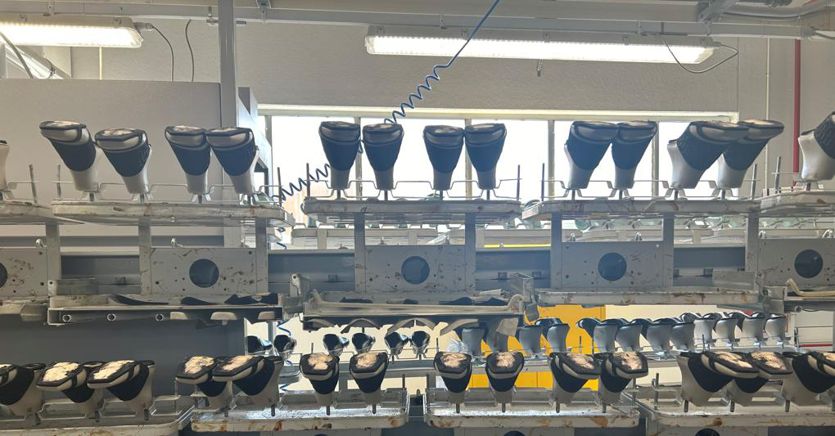Listen to the audio version of the article
A decline in orders, linked to the problems that luxury is facing, which has had an important impact on the production volumes of the leather supply chain represented by Confindustria Moda. A supply chain that brings together 11,500 companies and 150 thousand workers, for approximately 33 billion euros in revenues, and has significantly increased the use of social safety nets: the redundancy fund in February 2024 recorded a +189% compared to the same month of 2023. horizon, a series of geopolitical unknowns that could influence the costs of raw materials, logistics (just think of the blockade of traffic in the Red Sea) and consumption. And a series of “double-sided” measures such as the tax credit recognized between 2015 and 2019 for investments in Research & Development, a regulatory issue that companies have long been asking to be resolved. «We greatly appreciate the technical impulse offered by the Ministry of Made in Italy, with the Directorial Decrees of 21 February and 24 April 2024, but the controversial application of the 2015-2019 R&D tax credits must be clarified. Companies cannot be abandoned in the depths of this regulatory vulnerability and left faced with the dilemma of starting the spontaneous repayment procedure or facing investigations with an imponderable fiscal and even criminal outcome”. explained Annarita Pilotti, president of Confindustria fashion and footwear entrepreneur. According to Pilotti, “the moment is difficult for companies in the fashion and accessories sector and we need to work together to find support solutions that see the Government and employers’ associations working together”.
The issue of the R&D tax credit
The issue of the R&D tax credit for fashion companies dates back to March 2016 when circular 5/E/2016 of the then Ministry for Economic Development had also included research and development activities among the potential beneficiaries of the tax credit. development in the textile-fashion sector. Six years later, the Revenue Agency’s resolution 41/E of 26 July 2022, however, clarified that «all the activities that the company undertakes in its innovation process do not automatically fall within the scope of the tax credit, but exclusively those – carried out internally or commissioned externally – which are characterized by the presence of real research and development contents according to the classification and qualification criteria indicated above: that is to say, it is repeated, the activities that within a certain project aimed at introducing a new product (good or service) or a new process (production of a product) – or aimed at making significant improvements to existing products or processes – are necessary to overcome a problem or of a scientific or technological uncertainty, the solution of which would not be possible on the basis of the state of the art of the reference sector, i.e. by applying the techniques or knowledge already known and available in a specific scientific or technological sector”, states the provision.
Hence the options for companies: spontaneously remit the credit if the innovation made does not have the above characteristics, or incur possible investigations by the Revenue: «The Agency asks companies to repay in a manner spontaneous what the ministry had previously considered admissible, thus creating a legitimate expectation among the operators, changing the interpretation of the legislation – states the note from Confindustria Moda -. That tax credit – which the companies have legitimately had access to on the basis of legislation in force before July 2022 – was invested in new samples and collections. Asking for its restitution means running the risk of incurring both corporate defaults with consequent impacts on employment and the multiplication of disputes.”
The requests: more time to decide and settlement and cancellation
Hence the request to the government for «a further extension – hopefully to January 2025 – of the deadline within which companies must decide whether to adhere to the spontaneous transfer procedure, now established as 30 July 2024. In support of this request we highlight that the The Register of Certifiers (which brings together experts who can technically evaluate and validate projects and was established with a decree on 21 February 2024, ed.) is empty”. Among the companies’ requests also «a moratorium to temporarily interrupt the Revenue Agency’s controls and the consequent pressure on companies; access to a hypothesis of possible settlement and write-off on the disputed amount of the tax credit, to allow the contested companies to repay only part of the credit used without risking financial crises or definitive closures”. While waiting for a technical table at Mimit on the topic of the 2015-19 relief, the directorial decree of 24 April 2024 introduced a new communication model for the tax credit for investments in research and development activities, technological innovation, design and aesthetic conception: «We hope that FAQs will be published soon, which will clarify any interpretative doubts, so as to allow companies to peacefully access the tax exemptions relating to the next samples».
The crux of the loans to be repaid
Another key theme is that of the financing that companies have taken out both to deal with moments of crisis and to better manage the rebound in post-Covid orders (where it has occurred) and to implement a series of measures that should then materialise. the technological and green transition in the coming years. «To help them meet their obligations without running into a business crisis, we hope that the Government will adopt emergency measures which – albeit in compliance with European legislation – will allow the repayment times of the loans guaranteed by Sace and Simest to be extended so that The repayment horizon is increased, for companies in our sector, from 6 to 10 years”. Among Confindustria Moda’s requests to the government there is also «the opening of a working table with the banking system aimed at granting an extraordinary suspension on current account lines of credit, financing for advances on credits and loan installments, and financing in general for companies that request it”.
